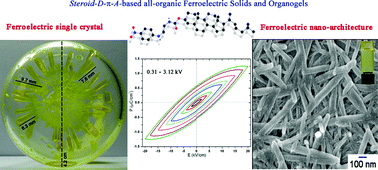An all-organic steroid–D–π-A modular design drives ferroelectricity in supramolecular solids and nano-architectures at RT†
Abstract
Confluence of a modular design approach and

* Corresponding authors
a
Supramolecular & Material Chemistry Lab, School of Physical Sciences, JNU, New Delhi, India
E-mail:
m_pritam@mail.jnu.ac.in
Fax: 91 11 26717537
Tel: 91 11 2673 8772
b School of Physical Sciences, JNU, New Delhi, India
c Department of Physics, IIT Delhi, India
d Polymer Science Unit, IACS, Kolkata, India
e
X-Ray Crystallography: Department of Chemistry, Nanoscience Center, University of Jyväskylä, JYU
E-mail:
kari.t.rissanen@jyu.fi
Confluence of a modular design approach and

 Please wait while we load your content...
Something went wrong. Try again?
Please wait while we load your content...
Something went wrong. Try again?
D. Asthana, A. Kumar, A. Pathak, P. K. Sukul, S. Malik, R. Chatterjee, S. Patnaik, K. Rissanen and P. Mukhopadhyay, Chem. Commun., 2011, 47, 8928 DOI: 10.1039/C1CC12398J
To request permission to reproduce material from this article, please go to the Copyright Clearance Center request page.
If you are an author contributing to an RSC publication, you do not need to request permission provided correct acknowledgement is given.
If you are the author of this article, you do not need to request permission to reproduce figures and diagrams provided correct acknowledgement is given. If you want to reproduce the whole article in a third-party publication (excluding your thesis/dissertation for which permission is not required) please go to the Copyright Clearance Center request page.
Read more about how to correctly acknowledge RSC content.
 Fetching data from CrossRef.
Fetching data from CrossRef.
This may take some time to load.
Loading related content
